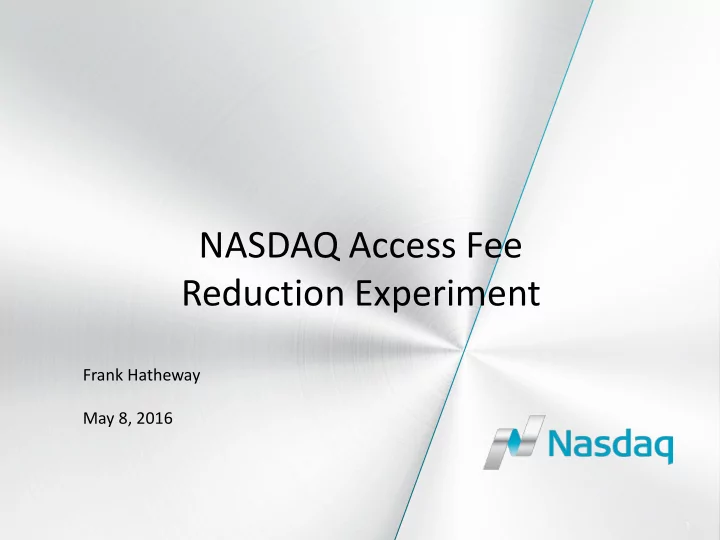

NASDAQ Access Fee Reduction Experiment Frank Hatheway May 8, 2016 1
NASDAQ Access Fee Experiment - Background “...[to] assess ... the role of access fees in order routing behavior by different types of market participants.” This program will generate much-needed data about the impact of the level of access fees on areas that matter most to investors and public companies such as the level of off-exchange trading, price discovery, trading costs, displayed liquidity and execution quality. • Structure of the Experiment: • 14 symbols (7 NYSE listed, 7 Nasdaq listed). The smallest is $2.5B in market cap • Reduce the access fee from $0.003 per share to $0.0005 per share • Began February 2, 2015 and will run for four months • Study effect on NASDAQ execution quality • Study effect on dark vs lit trading • Outlook: • First report released March 6th, the second on May 8th. • Market participants have reacted to the changes. • The reactions appear confined to liquidity providing trading strategies. 2 Nasdaq access fee experiment: Presented at NYU
NASDAQ Access Fee Experiment - Background Symbols represent a range of market cap, listing exchange, and ADV levels. The fee schedule is considerably simpler but maintains maker-taker characteristics. Fee changes are for continuous trading only and do not include auctions. 3 Nasdaq access fee experiment: Presented at NYU
NASDAQ Access Fee Experiment – Who Reacted By mid-March, there was little evidence of increased liquidity taking with the exception of two proprietary trading firms and one agency broker. At this point there is little reaction to the lower access fee from most institutional brokers, wholesalers, and retail brokers. This situation persisted through the end of April. 300000 250000 Daily Shares Removed 200000 Remove Before 150000 Remove After 100000 50000 Before period is January 2015. 0 After period is March 9 to 19, 2015 Firms’ identities removed 4 Nasdaq access fee experiment: Presented at NYU
NASDAQ Access Fee Experiment – Displayed Quote With a few exceptions, Nasdaq lost market share in the stocks in the experiment. In aggregate, the market share changes are statistically significant using a difference-in- difference approach . 5 Nasdaq access fee experiment: Presented at NYU
NASDAQ Access Fee Experiment – Time at the inside Time at the inside, or NBBO, is a simple measure of the quality of a market’s quote. Nasdaq’s average time at the NBBO declined 4.7 percentage points in the experiments stocks. There was no change in time at the inside in a group of 14 control stocks. The difference between the experiment and control stocks is statistically significant. Nasdaq’s average time at the NBBO decreased the most in TWTR by 24.2 percentage points and increased the most in GPRO by 0.2 percentage points. 6 Nasdaq access fee experiment: Presented at NYU
NASDAQ Access Fee Experiment – Liquidity Share Liquidity share measures quote quality using both time and size at the NBBO. Nasdaq’s liquidity share declined 10.0 percentage points in the experiment stocks and declined 1.9 percentage in the control stocks. The difference is statistically significant. The largest decrease in Nasdaq’s liquidity share was 16.4 percentage points in GRPN. The smallest decrease in liquidity share was 2.8 percentage points in BAC. The fact that Nasdaq’s liquidity share fell substantially and Nasdaq’s market share fell only slightly indicates that Nasdaq’s quote became relatively more attractive. 7 Nasdaq access fee experiment: Presented at NYU
NASDAQ Access Fee Experiment – Who Reacted Liquidity provision shows much more pronounced reactions to the lower liquidity provider rebate. By mid-March, the biggest percentage decreases in liquidity provision in the experiment stocks were from fee sensitive electronic market makers. This situation persisted through the end of April. 160000 140000 120000 Daily Shares Added 100000 Add Before 80000 Add After 60000 40000 20000 Before period is January 2015. 0 After period is March 9 to 19, 2015 Firms’ identities removed 8 Nasdaq access fee experiment: Presented at NYU
NASDAQ Access Fee Experiment – Who Reacted By mid-March, the biggest percentage increases in liquidity provision in the experiment stocks were from three buyside oriented firms, one retail firm, and interestingly one electronic market maker also increased liquidity provision. This situation persisted through the end of April. 250000 200000 Daily Shares Added 150000 Add Before Add After 100000 50000 Before period is January 2015. 0 After period is March 9 to 19, 2015 Firms’ identities removed 9 Nasdaq access fee experiment: Presented at NYU
Thank you Frank Hatheway +1 301 978 8220 Frank.hatheway@nasdaq.com The first access fee experiment report can be found here: http://www.nasdaqomx.com/digitalAssets/97/97754_nasdaq- access-fee-experiment---first-report.pdf 10 Nasdaq access fee experiment: Presented at NYU
Recommend
More recommend